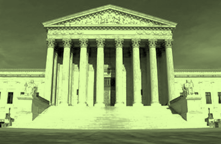
There may be a positive and surprising correlation between the country’s highest court and the adoption of energy saving lighting.
In its major decision on 6/25/15, the Supreme Court ruled that the federal subsidies that help about 6 million Americans pay for Obamacare are legal under the Affordable Care Act (ACA). The Justices probably did not consider the energy health of hospitals, clinics, and administrative buildings in their decision. However, the week after the ruling, one American LED manufacturer reported in a Press Release that a “leading healthcare provider informed Independence LED that they are going to move forward on a proposed LED retrofit precisely because of the decision.” Apparently, the federal subsidies, via the Affordable Care Act, would give the healthcare provider the financial confidence to invest in the LED technology, which typically carries a higher upfront cost than traditional lighting.
Charlie Szoradi, CEO of Independence LED, said, “Even though we offer $0 upfront cost financing as part of our LED lighting solutions, we are pleased to see that this new ruling helps healthcare providers move forward with energy intelligent lighting retrofits.”
Independence LED has provided LED solutions for healthcare clients since 2011, ranging from Jefferson University Hospital in Philadelphia to the massive NAVY hospital ship the Comfort, and from Urban Health Plan in New York to the first Veterans Affairs Hospital for the Durham Medical Center.
The company’s work for the VA Hospital replacing fluorescent tubes with LED tubes is also tangentially relevant given that the Supreme Court ruling came in just days before the Sunday re-broadcast of the 60 Minutes interview with Veterans Affairs Secretary Robert McDonald. The VA faces many challenges and saving money through energy reduction could help them hire many of the people that Secretary McDonald said were needed in his interview.
Interview excerpt: Scott Pelley: “How many doctors and nurses and medical professionals do you need to hire right now?”
Secretary McDonald: “If we could do it today we would tell you we probably need about 28,000, is what we said in our committee testimony.”
According to its Case Study on the VA LED tube retrofit (http://www.independenceled.com/VA-Medical-Center-LED-Retrofit-Case-Study), Independence LED is saving the Durham VA Medical Center over $17,000 per year in electricity costs, contributing to a lifetime energy savings of over $150,000. If every one of the more than 1,700 facilities in the VA health system were to convert to LED technology, the 10-year savings could exceed $1 Billion.
As the largest healthcare system in the US, the VA can benefit from leveraging the success of the LED tubes and other types of commercial LED lighting solutions.
Scope of impact:
According to the US Energy Information Administration (http://www.eia.gov/consumption/commercial/data/2003/), there are over 3 billion sq. ft. for more than 120,000 combined inpatient and outpatient healthcare facilities in America. At an average $1 per sq. ft. to retrofit with commercial LED lights and Return on Investment (ROI) over 33%, the annual energy savings is about a billion dollars each year. Since the LEDs last for between 7 and 20 years, subject to the run time, the total impact is over $13 billion of energy savings. Calculation cross check - Lighting for healthcare facilities currently consumes about 1.2 watts / sq. ft. according to ASHRAE (http://www.energycodes.gov/sites/default/files/becu/lighting07.pdf), and LED tubes at 16 watts or less can now replace the outdated 32 watt fluorescent tubes. The 50% savings of .6 watts per sq. ft. adds up to 1.8 billion watts saved. At a blended average of 12 hours per day for illumination (4,380 hours per year), the energy savings is 1.8b/1,000 x 4,380h = 7,884,000,000 kilowatt hours per year. At a US average of $.12 / kWh, this is $946 million per year in energy savings. Other benefits of LED tubes include less eye strain for healthcare professionals and less headaches for certain patients given the flicker of mercury lighting in fluorescent tubes. Plus, LED tubes save 1.341 lbs of CO2 for every kWh saved, so the positive impact on the environment is 10.5 billion lbs of CO2 each year and almost 140 billion lbs over the long life of the LED lighting. With about 8,000 lbs of CO2 emissions per car per year, LED tube retrofits for healthcare facilities will helps take the equivalent of 1.3 million cars off the road each year.
For the full Press Release with sources and case studies, see:
http://www.IndependenceLED.com/healthcare-impact

